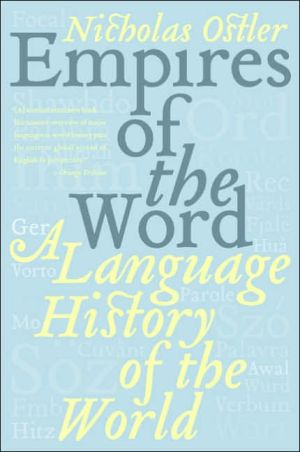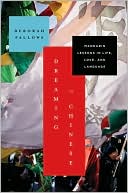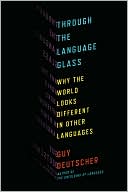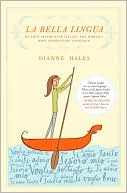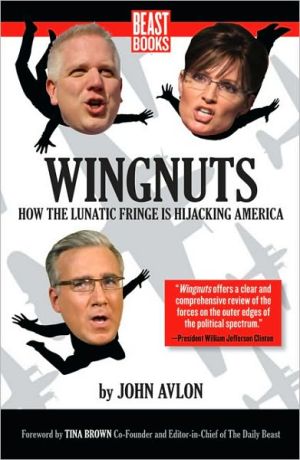Empires of the Word: A Language History of the World
The story of the world in the last five thousand years is above all the story of its languages. Yet the history of the world's great languages has been very little told. Empires of the Word, by the wide-ranging linguist Nicholas Ostler, is the first to bring together the tales in all their glorious variety: the amazing innovations in education, culture, and diplomacy devised by speakers of Sumerian and its successors in the Middle East, right up to the Arabic of the present day; the uncanny...
Search in google:
Head of the Foundation for Endangered Languages, Ostler draws on his extensive study and research, mostly into now dead languages, to trace the history of the world's major languages. Language is always linked to a particular time and place, he says, but at the same time it is a unbroken link to all people in all times, and has played a larger role in history than any prince or economy. First he considers early languages that became dominant in certain areas or by migration, then more recent ones that have spread throughout the world by colonialism. Annotation ©2004 Book News, Inc., Portland, OR Publishers Weekly Ostler's ambitious and accessible book is not a technical linguistic study-i.e., it's not concerned with language structure-but about the "growth, development and collapse of language communities" and their cultures. Chairman of the Foundation of Endangered Languages, Ostler's as fascinated by extinction as he is by survival. He thus traces the fortunes of Sumerian, Akkadian and Aramaic in the flux of ancient Middle Eastern military empires. Ancient Egyptian's three millennia of stability compares with the longevity of similarly pictographic Chinese-and provides a cautionary example: even a populous, well-defined linguistic community can vanish. In all cases, Ostler stresses the role of culture, commerce and conquest in the rise and fall of languages, whether Spanish, Portuguese and French in the Americas or Dutch in Asia and Africa. The rise of English to global status, Ostler argues, owes much to the economic prestige of the Industrial Revolution, but its future as a lingua franca may falter on demographic trends, such as booming birth rates in China. This stimulating book is a history of the world as seen through the spread and demise of languages. Maps. Agent, Natasha Fairweather at A.P. Watt Ltd. (July 8) Copyright 2005 Reed Business Information.
Empires of the Word\ A Language History of the World \ \ By Nicholas Ostler \ HarperCollins Publishers, Inc.\ Copyright © 2006 Nicholas Ostler\ All right reserved.\ ISBN: 0060935723 \ \ \ Chapter One\ Themistocles' Carpet\ The language view of human history\ From the language point of view, the present population of the world is not six billion, but something over six thousand.\ There are between six and seven thousand communities in the world today identified by the first language that they speak. They are not of equal weight. They range in size from Mandarin Chinese with some 900 million speakers, alone accounting for one sixth of all the people in the world, followed by English and Spanish with approximately 300 million apiece, to a long tail of tiny communities: over half the languages in the world, for example, have fewer than five thousand speakers, and over a thousand languages have under a dozen. This is a parlous time for languages.\ In considering human history, the language community is a very natural unit. Languages, by their nature as means of communication, divide humanity into groups: only through a common language can a group of people act in concert, and therefore have a common history. Moreover the language that a group shares is precisely the medium in which memories of their joint history can be shared.Languages make possible both the living of a common history, and also the telling of it.\ And every language possesses another feature, which makes it the readiest medium for preserving a group's history. Every language is learnt by the young from the old, so that every living language is the embodiment of a tradition. That tradition is in principle immortal. Languages change, as they pass from the lips of one generation to the next, but there is nothing about this process of transmission which makes for decay or extinction. Like life itself, each new generation can receive the gift of its language afresh. And so it is that languages, unlike any of the people who speak them, need never grow infirm, or die.\ Every language has a chance of immortality, but this is not to say that it will survive for ever. Genes too, and the species they encode, are immortal; but extinctions are a commonplace of palaeontology. Likewise, the actual lifespans of language communities vary enormously. The annals of language history are full of languages that have died out, traditions that have come to an end, leaving no speakers at all.\ The language point of view on history can be contrasted with the genetic approach to human history, which is currently revolutionising our view of our distant past. Like membership in a biological species and a matrilineal lineage, membership in a language community is based on a clear relation. An individual is a member of a species if it can have offspring with other members of the species, and of a matrilineal lineage if its mother is in that lineage. Likewise, at the most basic level, you are a member of a language community if you can use its language.\ The advantage of this linguistically defined unit is that it necessarily defines a community that is important to us as human beings. The species unit is interesting, in defining our prehistoric relations with related groups such as Homo erectus and the Neanderthals, but after the rise of Homo sapiens its usefulness yields to the evident fact that, species-wise, we are all in this together. The lineage unit too has its points, clearly marked down the aeons as it is by mitochondrial DNA and Y-chromosomes, and can yield interesting evidence on the origin of populations if some lineage clearly present today in the population is missing in one of the candidate groups put forward as ancestors. So it has been inferred that Polynesians could not have come from South America, that most of the European population have parentage away from the Near Eastern sources of agriculture, and that the ancestry of most of the population of the English Midlands is from Friesland. But knowing that many people's mothers, or fathers, are unaccounted for does not put a bound on a group as a whole in the way that language does.\ Contrast a unit such as a race, whose boundaries are defined by nothing more than a chosen set of properties, whether as in the nineteenth and early twentieth centuries by superficial resemblances such as skin colour or cranial proportions, or more recently by blood and tissue groups and sequences of DNA. Likewise, there are insurmountable problems in defining its cultural analogue, the nation, which entail the further imponderables of a consciousness of shared history, and perhaps shared language too. Given that so many of the properties get shuffled on to different individuals in different generations, it remains moot as to what to make of any set of characteristics for a race or a nation.* But use of a given language is an undeniable functioning reality everywhere; above all, it is characteristic of every human group known, and persistent over generations. It provides a universal key for dividing human history into meaningful groups.\ Admittedly, a language community is a more diffuse unit than a species or a lineage: a language changes much faster than a DNA sequence, and one cannot even be sure that it will always be transmitted from one generation to the next. Some children grow up speaking a language other than their parents'. As we shall soon see, language communities are not always easy to count, or to distinguish reliably. But they are undeniably real features of the human condition.\ The task of this book is to chart some of the histories of the language traditions that have come to be most populous, ones that have spread themselves in the historic period over vast areas of the inhabited world. Our view will be restricted to language histories for which there is direct written evidence, and this means omitting some of the most ancient, such as the spread of Bantu across southern Africa, or of the Polynesian languages across the Pacific; but nevertheless the tale is almost always one that covers millennia ...\ \ Continues... \ \ \ \ Excerpted from Empires of the Word by Nicholas Ostler Copyright © 2006 by Nicholas Ostler. Excerpted by permission.\ All rights reserved. No part of this excerpt may be reproduced or reprinted without permission in writing from the publisher.\ Excerpts are provided by Dial-A-Book Inc. solely for the personal use of visitors to this web site. \ \
Prologue : a clash of languages11Themistocles' carpet72What it takes to be a world language; or, you never can tell183The desert blooms : language innovation in the Middle East29First interlude : whatever happened to Elamite?56Second interlude : the shield of faith86Third interlude : Turkic and Persian, outriders of Islam1054Triumphs of fertility : Egyptian and Chinese1135Charming like a creeper : the cultured career of Sanskrit1746Three thousand years of solipsism : the adventures of Greek2277Contesting Europe : Celt, Roman, German and Slav2728The first death of Latin3159The second death of Latin32510Usurpers of greatness : Spanish in the New World33111In the train of empire : Europe's language abroad38012Microcosm or distorting mirror? : the career of English45613The current top twenty52514Looking ahead534
\ From Barnes & NobleNicholas Ostler's study on the co-evolution of languange and human society is one of the most revelatory books we've recently come across. Despite the author's role as the head of the Foundation for Endangered Languages, this is no dry linguistic study but a landmark of both storytelling and cultural analysis, weaving together ancient Mespotamian politics, Chinese dynasties, Greek philosophers, the worldwide spread of English, and more.\ \ \ \ \ Publishers WeeklyOstler's ambitious and accessible book is not a technical linguistic study-i.e., it's not concerned with language structure-but about the "growth, development and collapse of language communities" and their cultures. Chairman of the Foundation of Endangered Languages, Ostler's as fascinated by extinction as he is by survival. He thus traces the fortunes of Sumerian, Akkadian and Aramaic in the flux of ancient Middle Eastern military empires. Ancient Egyptian's three millennia of stability compares with the longevity of similarly pictographic Chinese-and provides a cautionary example: even a populous, well-defined linguistic community can vanish. In all cases, Ostler stresses the role of culture, commerce and conquest in the rise and fall of languages, whether Spanish, Portuguese and French in the Americas or Dutch in Asia and Africa. The rise of English to global status, Ostler argues, owes much to the economic prestige of the Industrial Revolution, but its future as a lingua franca may falter on demographic trends, such as booming birth rates in China. This stimulating book is a history of the world as seen through the spread and demise of languages. Maps. Agent, Natasha Fairweather at A.P. Watt Ltd. (July 8) Copyright 2005 Reed Business Information.\ \ \ Library JournalOstler presents a masterly comparative analysis of empires' linguistic effects throughout history. An Oxford graduate and chair of the Foundation for Endangered Languages, Ostler writes in a concise yet engaging manner, displaying an impressive grasp of the history of languages, from Aramaic and Sanskrit to Chinese and Spanish. Language, he asserts, is a natural definer of communities and societies and therefore an integral part of history. Ostler analyzes the different ways in which certain languages have prevailed over others, chronologically and in relation to broader imperial pursuits. For example, Egyptian fell by the wayside during the successive rule of the Roman, Byzantine, and Islamic empires; in contrast, Chinese has remained strong despite the incursion of the Mongols, Manchus, and challenges from Western powers in the 19th century. Ostler's study ultimately shows that all languages are susceptible to downfall; even the current, unprecedented prevalence of English, aided by global communication and trade, is neither impervious nor eternal. This book is accessible to anyone with an interest in language, and its original ideas, generous notes, and extensive bibliography make it well suited to academic libraries as well.-Rebecca Bollen Manalac, Lane Cove Lib., Sydney, Australia Copyright 2005 Reed Business Information.\ \ \ \ \ Christian Science Monitor"A work of immense erudition."\ \ \ \ \ Boston magazine“Revolutionary... Executed with a giddying depth of scholarship, yet the detail is never too thick to swamp the general reader.”\ \ \ \ \ Los Angeles Times Book Review"A story of dramatic reversals and puzzling paradoxes. A rich... text with many piercing observations and startling comparisons."\ \ \ \ \ Literary Review"What an extraordinary odyssey the author of this superb work embarked upon."\ \ \ \ \ Chicago Tribune"[A] monumental new book... Ostler furnishes many fresh insights, useful historical anecdotes and charming linguistic oddities."\ \ \ \ \ Washington Post"[A] wide-ranging history of the world’s languages... [Ostler] brilliantly raises questions and supplies answers or theories."\ \ \ \ \ National Review"True scholarship. A marvelous book, learned and instructive."\ \ \ \ \ John McWhorter"Delicious! Ostler’s book shows how certain lucky languages joined humankind in its spread across the world."\ \ \ \ \ John Leonard"Covers more rambunctious territory than any other single volume I’m aware of...A wonderful ear for the project’s poetry."\ \ \ \ \ Boston Magazine"Revolutionary... Executed with a giddying depth of scholarship, yet the detail is never too thick to swamp the general reader."\ \
